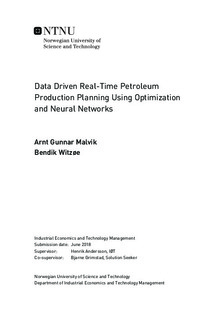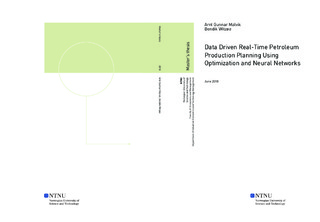| dc.description.abstract | Real-time optimization (RTO) of petroleum production is concerned with maximizing daily oil production by suggesting minor adjustments to the system and frequently re-solving the optimization model. A central part of the problem consists of modeling well production outputs as a function of decision variable inputs.
Most petroleum production fields have an upper limit on the rate of gas they are able to handle under normal conditions. Providing decision support for adhering to this constraint is complicated by uncertainty in the gas output rates of wells, stemming from uncertain measurement data and the well model approximations to the data. Accounting for both sources is necessary in order to avoid underestimating the total uncertainty.
A maximally risk-averse system operator seeks to avoid gas capacity constraint breaches at all times. However, if the utility of the operator is unknown, there exists a set of Pareto optimal solutions that describe the trade-off between petroleum production and uncertainty in the gas output. In this thesis, we formulate a robust stochastic mixed integer linear program (MILP) for the case of maximum risk aversion, and a multi-objective optimization problem (MOP) which models the oil production and gas uncertainty trade-off.
We propose a novel model of well outputs as a function of inputs, combining state-of-the-art neural network (NN) techniques and thereby obtaining a statistically grounded distribution of outputs, capturing both data and model uncertainty. The NN well models are reformulated as MILPs and included in the optimization problems. Two scenario generation procedures based on the NN well models are presented, producing Factor and Markov Weighted scenarios. A recourse algorithm (RA) is developed, modeling the discovery of new information as operational changes are implemented. We test the models developed in this thesis on a simplified representation of a real oil field.
Scenarios are represented by NN MILPs or special ordered sets. Results show NN MILPs offer poor scalability as the number of scenarios in the problem increases. Identified weaknesses in the Factor scenarios cause excessively conservative solutions and make them incompatible with cases where initial production levels are known. The value of planning with uncertainty in the robust problem depends on the choice of a suitable penalty metric for infeasible solutions, but is found to be significant. The RA offers significant performance gains over the standard robust approach in certain cases. However, performance estimates are slightly optimistic due to simplifications in the RA implementation.
MOP results prove to be suited for identifying the optimal solution for a given level of risk aversion. In particular, we obtain confidence intervals for the probability of a gas capacity constraint breach given a specified minimum oil output. Convergence of the RA and the MOP results indicate that Markov Weighted scenarios are a sensible representation of the distribution of the uncertainty in the problem. | en |

